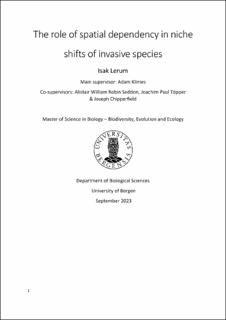The role of spatial dependency in niche shifts of invasive species
Master thesis

View/
Date
2023-09-01Metadata
Show full item recordCollections
- Master theses [269]
Abstract
Invasive species are an ongoing threat to nature and human interests. Species distribution models are used to predict the current and potential distribution of invasive species, but doing so has proved difficult. One possible cause of this difficulty are niche shifts, a change in the realised or fundamental niche between native and introduced ranges. Niche shifts have mostly been studied by approximating the realised niche, which often underestimates the true ecological constraints of a species as a result of biotic interactions and dispersal mechanisms. This study employs a new model that is more theoretically suitable to approximate the fundamental niche. The model features a spatial random effect that accounts for spatial processes in the data, distinguishing them from the environmental effects (fundamental niche). I find that in the datasets of previous niche shift studies the spatial effects dominate the environmental ones too such a degree that the fundamental niche cannot be reliably approximated. This is the case for both the native and introduced ranges for the invasive species, indicating that spatial effect domination is the norm for species in general, not just invasive species in their introduced ranges. Even if the fundamental niche could be estimated from some other method than species distribution modelling it would still have limited usefulness in predicting the species’ distribution. The fundamental niche could still be used to predict the distribution of potentially suitable habitat, which is useful for selecting areas to establish preventative measures. But due to the strong spatial effects it will not produce reliable predictions of the distribution of the invasive species for selecting where restorative measures (eradication/culling of the invasive or support for harmed native species).